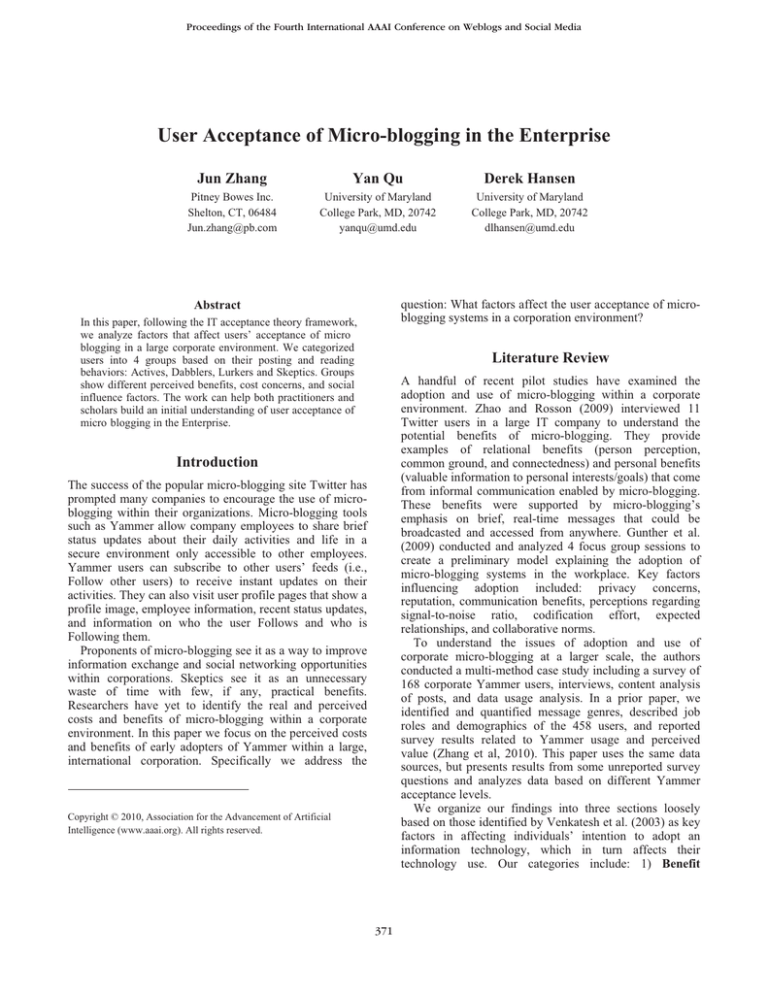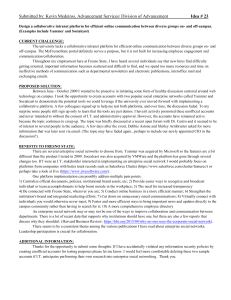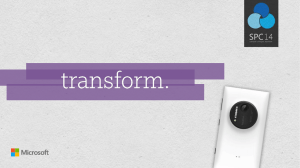
Proceedings of the Fourth International AAAI Conference on Weblogs and Social Media
User Acceptance of Micro-blogging in the Enterprise
Jun Zhang
Yan Qu
Derek Hansen
Pitney Bowes Inc.
Shelton, CT, 06484
Jun.zhang@pb.com
University of Maryland
College Park, MD, 20742
yanqu@umd.edu
University of Maryland
College Park, MD, 20742
dlhansen@umd.edu
question: What factors affect the user acceptance of microblogging systems in a corporation environment?
Abstract
In this paper, following the IT acceptance theory framework,
we analyze factors that affect users’ acceptance of micro
blogging in a large corporate environment. We categorized
users into 4 groups based on their posting and reading
behaviors: Actives, Dabblers, Lurkers and Skeptics. Groups
show different perceived benefits, cost concerns, and social
influence factors. The work can help both practitioners and
scholars build an initial understanding of user acceptance of
micro blogging in the Enterprise.
Literature Review
A handful of recent pilot studies have examined the
adoption and use of micro-blogging within a corporate
environment. Zhao and Rosson (2009) interviewed 11
Twitter users in a large IT company to understand the
potential benefits of micro-blogging. They provide
examples of relational benefits (person perception,
common ground, and connectedness) and personal benefits
(valuable information to personal interests/goals) that come
from informal communication enabled by micro-blogging.
These benefits were supported by micro-blogging’s
emphasis on brief, real-time messages that could be
broadcasted and accessed from anywhere. Gunther et al.
(2009) conducted and analyzed 4 focus group sessions to
create a preliminary model explaining the adoption of
micro-blogging systems in the workplace. Key factors
influencing adoption included: privacy concerns,
reputation, communication benefits, perceptions regarding
signal-to-noise ratio, codification effort, expected
relationships, and collaborative norms.
To understand the issues of adoption and use of
corporate micro-blogging at a larger scale, the authors
conducted a multi-method case study including a survey of
168 corporate Yammer users, interviews, content analysis
of posts, and data usage analysis. In a prior paper, we
identified and quantified message genres, described job
roles and demographics of the 458 users, and reported
survey results related to Yammer usage and perceived
value (Zhang et al, 2010). This paper uses the same data
sources, but presents results from some unreported survey
questions and analyzes data based on different Yammer
acceptance levels.
We organize our findings into three sections loosely
based on those identified by Venkatesh et al. (2003) as key
factors in affecting individuals’ intention to adopt an
information technology, which in turn affects their
technology use. Our categories include: 1) Benefit
Introduction
The success of the popular micro-blogging site Twitter has
prompted many companies to encourage the use of microblogging within their organizations. Micro-blogging tools
such as Yammer allow company employees to share brief
status updates about their daily activities and life in a
secure environment only accessible to other employees.
Yammer users can subscribe to other users’ feeds (i.e.,
Follow other users) to receive instant updates on their
activities. They can also visit user profile pages that show a
profile image, employee information, recent status updates,
and information on who the user Follows and who is
Following them.
Proponents of micro-blogging see it as a way to improve
information exchange and social networking opportunities
within corporations. Skeptics see it as an unnecessary
waste of time with few, if any, practical benefits.
Researchers have yet to identify the real and perceived
costs and benefits of micro-blogging within a corporate
environment. In this paper we focus on the perceived costs
and benefits of early adopters of Yammer within a large,
international corporation. Specifically we address the
Copyright © 2010, Association for the Advancement of Artificial
Intelligence (www.aaai.org). All rights reserved.
371
Perception – the degree to which an individual believes
that using the system will help him or her improve job
performance. This is directly related to Venkatesh et al.’s
“performance expectancy” factor, although we explicitly
recognize that social media platforms like micro-blogging
tools are more likely to impact one’s work indirectly
through maintaining and developing social relations and
new informal communication channels (Zhao & Rosson,
2009). This is similar to DiMacco et al.’s (2008) finding
that corporate social networking sites are useful in building
and maintaining weak ties. 2) Cost Perception – the
degree to which an individual believes that using the
system will cost him or her in terms of expected time,
difficulty of using the system, and potential risks including
privacy and security infringement. 3) Social Influence –
the degree to which an individual perceives that important
others believe he or she should use the new system. Social
influence includes both injunctive norms (what other
people think you should do) and descriptive norm (what
other people do).
Each member’s total number of posts (i.e., Yammer
status updates) is used to indicate a different type of
acceptance. Those who never posted are separated from
those who posted at least one message.
Posts (>=1 posts)
No posts (0 post)
Frequent reading
(at least once a
day)
Actives: 35
Lurkers: 8
Infrequent
reading (less than
once a day)
Dabblers: 32
Skeptics: 73
Table 1: Four Groups of Yammer users with different
acceptance levels
Figure 1 shows the two key variables on the same graph,
using the posting score of log((n+1),2) where n is the
number of messages posted. Figure 1 shows that users who
read more typically post more (Reading and Posting scores
are weakly correlated (r = 0.35). However, there are users
who read frequently but don’t post much (i.e., lurkers).
There are also individuals who posted initially, but by the
time they took the survey indicated that they do not read
messages anymore, suggesting they have abandoned the
system.
Data & Measurement
Data overview
Our analysis is based on a case study from a large fortune
500 company, XB (a pseudonym). XB’s business includes
manufacturing, servicing, and software. It has over 30,000
employees worldwide. We rely on 5 months of user
posting activity log data from all 458 early adopters of
Yammer, as well as survey result from 168 Yammer users
(37% acceptance rate). All data were collected in June
2009. Survey respondent data were matched with Yammer
IDs, allowing us to associate the results from each source.
See (Zhang et al, 2010) for a more detailed description of
data collection, XB Yammer, and potential survey sample
bias toward slightly more active users.
Reading
Posting
10
9
8
7
6
5
4
3
2
1
0
Figure 1: Users’ reading level and posting score
Analysis Results
Measuring Acceptance
Benefit Perception
Technology acceptance is a multifaceted construct
including measures of adoption and use. In this paper we
compare the perceived benefits, costs, and social influence
factors of 4 distinct groups of users identified in Table 1.
The groups are based on two dimensions: Their selfreported reading frequency and their actual posting data.
All of the groups include those who registered for Yammer.
Data on individuals who did not accept Yammer invites
(about half of invitees) is being collected for future work.
Reading levels were assessed by a survey question
asking users how often they read Yammer. Answers were
chosen from the following options:
Survey respondents rated the overall usefulness of
Yammer, as well as its usefulness for a number of specific
variables (see Figure 2). The average ratings on a 5-point
scale ranging from -2 (strongly disagree) to 2 (strongly
agree) is reported for each of the 4 acceptance groups.
As expected, the Actives (frequent reading and non zero
posting) have the highest overall rating for Yammer’s
usefulness. The Dabblers and Lurkers had lower but still
positive ratings. As expected, the Skeptics (infrequent
reading, no posting) do not perceive Yammer as being
useful on average. This result confirms the correlation
between benefit perception and technology use theorized
by Venkatesh et al. (2003).
Data on specific perceived benefits shows some
surprising results. In general, the Actives and the Dabblers
have very consistent, and generally positive perceptions,
despite the fact that the Dabblers read infrequently, if at all.
The lurkers are less positive than all groups but the
Skeptics. The Lurkers were differed from those who had
Reading level = 5 - Real time; 4 - Couple of times a
day; 3 - Once a day; 2 - Only when prompted by
others; 1 – Occasionally; 0 - Read for a few days after
joining, then stopped reading it.
We roll these up into 2 groups: Frequent readers (answers
3,4,5) and Infrequent readers (answers 0,1,2).
372
G1: Actives
G2: Dabblers
G3: Lurkers
G4: Skeptics
1.5
1
0.5
0
-0.5
Q17 Solve problems
Q16 Ask questions
Q15 Generate partnership
leads
Q14 Generate sales leads
Q13 Generate ideas
Q12 Get info about the
industry
Q11 Get info about the
company
Q10 Get info about ohers' work
Q9 Conn ppl at diff level
Q8 Conn ppl at diff unit
Q7 Conn ppl at diff loc
Q6 Conn unkown ppl
Q5 Conn ppl with similar
interests
Q4 Conn peers
Q3 Conn ppl at same unit
Q2 Conn ppl at same loc
Q1 conn known ppl
-1.5
Overall usefulness rating
-1
Figure 2: Different groups’ benefit perception of Yammer: -2 (strongly disagree that it is valuable) ~ 2 (strongly agree that it is
valuable to me)
posted in that they did not perceive Yammer as valuable
for connecting to people in the same location, people that
they already knew, or their peers. This may be because
their peers are not on Yammer, which may help explain
why they do not post (i.e., they don’t have any known
friends to talk to). As expected, the Skeptics who do not
post or read have a negative perceived value on all
dimensions.
As a whole, users are more positive about Yammer’s
value in helping them finding people whom they don’t
know or are not similar to (Q6, Q7, Q8, Q9 – people whom
they don’t know, or people from different location, unit, or
level) than Yammer’s value in helping them finding people
whom they know or are similar to (Q1, Q2, Q3, Q4, Q5 –
people whom they know, people from the same location,
unit, or level, or people with similar interests). This may
change as membership increases. Furthermore, users value
Yammer’s function in getting information about what other
people are doing (Q10) and helping them reach other
people and asking questions (Q16) more than its function
in getting general corporation or industrial news (Q11,
Q12), helping generate ideas, sales leads or official
partnerships (Q13, Q14, Q15), or solving a problem (Q17).
report “privacy concern” as a big barrier. “Bad interface” is
not selected as a barrier by most groups, but all the groups
reported “Still learning to use the system” as an important
reason for not posting more messages. This indicates that
while the interface of Yammer is not a barrier, the social
practice of what to post and related micro-blogging
concepts (i.e. following and hash-tagging) are still
confusing for many users, as reported in other related
survey questions and interviews.
Cost Perception
The “time” related cost is highly related to the noisevalue issue that we identified in our previous work (Zhang
et al. 2010). The noise-value issue referred to that it is
difficult for users to find relevant information valuable to
them from tons of Yammer postings. The following quotes
are telling:
G1: Actives
G2: Dabblers
G3: Lurkers
G4: Skeptics
04
0 35
03
0 25
02
0 15
01
0 05
er
fa
c
in
t
nc
Ba
ac
y
Pr
iv
d
co
on
C
y
cu
r it
e
er
ns
s
ce
rn
ar
ni
ng
le
St
ill
Se
D
on
'
th
av
e
tim
e
0
Figure 3: Cost factors of Yammer adoption
Figure 3 shows the cost related factors from the question
“what were your reasons for not posting messages in
Yammer?” From the figure, we can see that “Don’t have
time” is the top reason for Dabblers and Skeptics. For the
Lurkers, “Don’t have time, still learning, and security
concerns” are equally important reasons for them to post.
Interestingly, Lurkers are also the only group that didn’t
373
“The value to me has been finding out what projects
other people are working on, but the S/N ration is
waaaay to high.”
Acknowledgements
We would like to thank Aneta Hall, Tom Foth, Jane Cody,
and Yuling Wu for insightful discussions. We would also
like to thank all of our survey participants and Yammer Inc.
for their support to our research.
“There are too many things to read, follow and take
part in since joining XB. I cannot understand how if
you do them all, how you could possibly get any work
done.”
Reference
“Its been hard to devote time to it. Not sure if I have
found the right balance between participation and
spending too much time on it.”
DiMicco, J., Millen, D. R., Geyer, W., Dugan, C.,
Brownholtz, B., and Muller, M. 2008. Motivations for
social networking at work. In Proceedings of the 2008
ACM Conference on Computer Supported Cooperative
Work, San Diego, CA, USA, November 08 - 12, 2008,
711-720
Both the system and security issue could be mitigated,
however, pursing the balance of spending time on social
media and work is one of the biggest challenges for users’
adoption of Yammer-like social applications in companies.
Günther, O.; Krasnova, H.; Riehle, D.; and Schoendienst,
V., 2009, "Modeling Microblogging Adoption in the
Enterprise", in Proceedings of AMCIS2009. San Francisco,
Aug., 2009.
Social Influence
Figure 4 shows social influence related factors from the
question “What motivates you to participate on Yammer?”
From this figure, we can see that “my-co-workers
participate” is clearly the most important factor for all
groups, suggesting that peer participation is important to
acceptance in a grassroots social media roll-out. “My
manager participates” is a motivating factor for all but the
Skeptics. Interestingly, both Actives and Skeptics do not
view “Management approval” as a motivating factor.
G1: Actives
G2: Dabblers
G3: Lurkers
Venkatesh, V., Morris, M.G., Davis, G.B., and Davis, F.D.
"User Acceptance of Information Technology: Toward a
Unified View," MIS Quarterly (27:3), Sept. 2003, 425-478.
Zhang, J., Qu, Y., Cody, J., Wu, YL., “A Case Study of
Micro-blogging in the Enterprise: Use, Value, and Issues”,
To appear in Proceedings of CHI2010, Atlanta, Georgia,
Apr. 2010, ACM Press.
G4: Skeptics
1
Zhao, D. and Rosson, M. 2009. How and why people
Twitter: the role that micro-blogging plays in informal
communication at work. In Proceedings of the ACM
Group2009, Sanibel Island, FL, USA, May, 2009, 243-252.
08
06
04
02
0
02
04
Management approval My manager participate
My co-worker
participate
Figure 4: Social influence factors of Yammer adoption
Discussion
Our analysis confirmed that factors related to benefits
perception, cost concerns, and social influence all
contribute to users’ acceptance behaviors. More
importantly, by categorizing users to different groups by
their reading and posting behaviors, we identified different
benefits, costs, and social influence factors for different
groups. This suggests that the concept of acceptance must
be dealt with as a complex variable, particularly in a social
media platform like Yammer. In the future, we plan to
combine these data with user’s demographic information
and other activity data (i.e. invitation and following data)
to further study this important problem.
374







